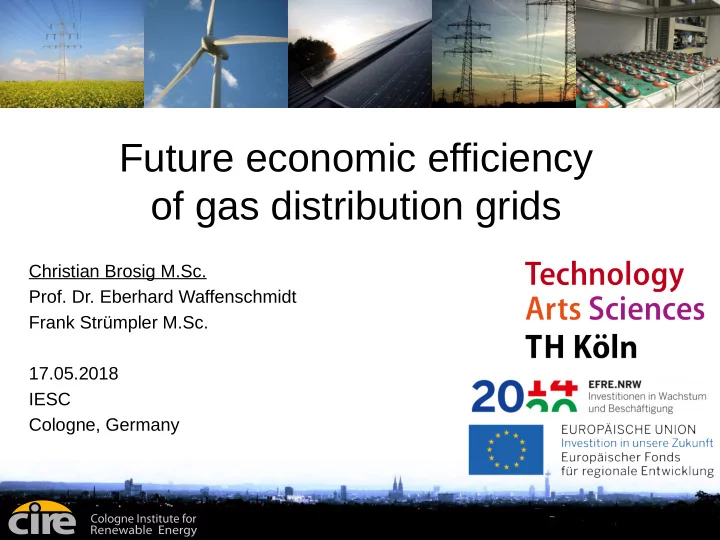

Future economic efficiency of gas distribution grids Christian Brosig M.Sc. Prof. Dr. Eberhard Waffenschmidt Frank Strümpler M.Sc. 17.05.2018 IESC Cologne, Germany
The case Decreasing consumption [1] BMWI: Energiedaten gesamt, 2016. 2
The case Renovation Decreasing consumption rates 2
The case Decreasing Renovation Electrification consumption rates Will we need gas distribution grids in the future? 2
Future energy prices [2] V. Bürger, T. Hesse, D. Quack, A. Palzer, B. Köhler, S. Herkel, and P. Engelmann, Klimaneutraler Gebäudebestand 2050, 2016. 3 [3] Agora Verkehrswende, Agora Energiewende, Frontier Economics Ltd., Die zukünftigen Kosten strombasierter synthetischer Brennstoffe, 2018
Methodology 4
Grid structure: benchmark grid [4] C. Brosig, S. Fassbender, E. Waffenschmidt, S. Janocha, and B. Klaassen, “Benchmark 5 gas distribution network for cross-sectoral applications,” in 2017 International Energy and Sustainability Conference (IESC), Oct. 2017, pp. 1–5. DOI :10.1109/IESC.2017.8283183.
Grid structure: benchmark grid user Connection rate Consumption [kWh/year] 526 HH 0.7 4 799 487 339 SFH 0.7 8 277 024 164 RH 0.7 2 878 036 school 1 749 980 hospital 1 3 420 000 Sum 20 124 547 [4] C. Brosig, S. Fassbender, E. Waffenschmidt, S. Janocha, and B. Klaassen, “Benchmark 6 gas distribution network for cross-sectoral applications,” in 2017 International Energy and Sustainability Conference (IESC), Oct. 2017, pp. 1–5. DOI :10.1109/IESC.2017.8283183.
Yearly costs Piping costs * OPEX 5 €/m pipe Pressure regulator stations 4 x 100 000 € *weighted average cost of capital [5] A. Scheunemann and M. Becker, Kennziffernkatalog: Investitionsvorbereitung 7 in der Energiewirtschaft, 2004.
Yearly costs * Assumptions risk-free Implicit Beta Equ. Market DCIR** lifespan IR*** tax rate risk factor share IR** 3.7 % 0.5 % 20.5 % 0.95 15 % 5.7 % 55 a *weighted average cost of capital; **debt capital interest rate; ***interest rate 7
Revenue Ceiling [1] influencable non-influencable costs costs market situation temporarily non-influencable costs → neglected factors [6] Anreizregulierungsverordnung vom 29. Oktober 2007 (BGBl. I S. 2529), which 8 last has been changed by Article 5 of the law from17. July 2017 (BGBl. I S. 2503)
Results grid charge = revenue ceiling → 1.85 Cent/kWh total gas demand 9
Sensitivities Equity share = 50 % With given assumptions 10
Scenarios Scenario I: Efficiency ● Efficiency measures without electrification ● Exchange of fuel oil based heating by gas based on 2016 [7] ● Reduction of space heating and warm water: 18 % - 54 % [8] [7] BMWI, Energiedaten gesamt, 2018 11 [8] AEE, Metaanalyse Strom und Wärme, 2017
Scenarios Scenario I: Efficiency ● Efficiency measures without electrification ● Exchange of fuel oil based heating by gas based on 2016 [7] ● Reduction of space heating and warm water: 18 % - 54 % [8] Scenario II ● Electrification on basis of efficiency measures ● Heat pump installation in Germany from 14.56 to 244.56 TWh [8] [7] BMWI, Energiedaten gesamt, 2018 11 [8] AEE, Metaanalyse Strom und Wärme, 2017
Scenarios Scenario I: Efficiency ● Efficiency measures without electrification ● Exchange of fuel oil based heating by gas based on 2016 [7] ● Reduction of space heating and warm water: 18 % - 54 % [8] Scenario II ● Electrification on basis of efficiency measures ● Heat pump installation in Germany from 14.56 to 244.56 TWh [8] Scenario III ● Renewable gas only [7] BMWI, Energiedaten gesamt, 2018 11 [8] AEE, Metaanalyse Strom und Wärme, 2017
Scenario I: Efficiency ● Proportionally transferred to the benchmark grid ● Leads to a grid charge → 1.56 Cent/kWh – 4.03 Cent/kWh [7] BMWI, Energiedaten gesamt, 2018 12 [8] AEE, Metaanalyse Strom und Wärme, 2017
Scenario II: Electrification ● Proportionally transferred to the benchmark grid ● Leads to a grid charge → 1.61 Cent/kWh – 29.58 Cent/kWh [7] BMWI, Energiedaten gesamt, 2018 13 [8] AEE, Metaanalyse Strom und Wärme, 2017
Scenario III: Renewable gas ● Connection of biogas or methanation = add. Costs → marginal in comparison to the total grid ● Supply with renewable gas only is feasible → imported! → but profitable? ● 100 % renewables: „cold dark lull“ → CHPs instead of gas power plants to fill these weeks? → evaluation needed → political decision 14
Gas-price vs. Electricity-price [3] Agora Verkehrswende, Agora Energiewende, Frontier Economics Ltd., Die 15 zukünftigen Kosten strombasierter synthetischer Brennstoffe, 2018
Discussion ● Exchange of fuel oil with gas will need further investments to connect houses to the gas grid ● Were not yet included! ● Grid charge is logarithmically distributed depending on the yearly gas demand ● Leads to higher grid charges for households! 16
Conclusion ● Exchange of fuel oil with gas is able to buffer gas consumption losses, but... ● Investment measures might not add up to the gain ● Heat-pumps will become less expansive than gas heating by 2020 to 2025 ● Parts of the gas distribution grid should be shut down in future, to prevent grid charges from rising ● CHPs with renewable gas could have the potential to ● save parts of the gas distribution grid ● release stress from the electrical grid 17
Recommend
More recommend